A Practical Method for Trace Level Analysis of Chlorinated Organic Pesticides by Gas Chromatography–Mass Spectrometry
LCGC North America
A review of a gas chromatographic procedure developed for the direct measurement of trace levels of lindane, aldrin, heptachlor epoxide, dieldrin, o,p-DDD, and dichlorodiphenyltrichloroethane (DDT)
This article discusses a practical and reliable gas chromatographic procedure that has been successfully developed for the direct measurement of trace levels of lindane, aldrin, heptachlor epoxide, dieldrin, o,p-DDD, and dichlorodiphenyltrichloroethane (DDT). With appropriate sample preparation, this analytical technique can be applied to matrices such as soil, consumer products, fruits, and vegetables.
Chlorinated organic pesticides are chemical substances that are widely used against household, garden, and plant pest diseases. The use of pesticides, however, demands great care and control as they can enter the environment and have a negative impact on human health. For instance, lindane is a persistent organic pollutant with a relatively long life in the environment, it is transported long distances by natural processes like global distillation, and can bioaccumulate in food chains. Dieldrin and aldrin are chemicals that were widely applied in agricultural areas throughout Canada and the world. Both chemicals are toxic and bioaccumulative. Aldrin does break down to dieldrin in living systems, but dieldrin is known to resist bacterial and chemical breakdown processes in the environment. Heptachlor epoxide is another commonly employed insecticide and is a well known persistent organic pollutant (POP). Dichlorodiphenyltrichloroethane (DDT) is one of the most well publicized synthetic insecticides, with a unique and controversial history especially with birds.

The topic of analyzing ultratrace levels of chlorinated pesticides has been reported by researchers with many references in the open literature (1–5). Developed techniques include the incorporation of sample enrichment devices such as headspace, purge-and-trap, solid-phase extraction (SPE), solid-phase microextraction (SPME), and stir-bar sorptive enrichment with selective detection like electron capture or electrolytic conductivity detection, as well as with the employment of mass spectrometry (MS) (5–10). One of the issues commonly reported by researchers is the decomposition and irreversible adsorption of the organopesticides in the solute path from inlet liner to the column used and even inside the detectors, especially with mass spectrometers (5–15). Recently, highly inert quartz wool–filled liners (14), column technologies, and mass spectrometers have been innovated and commercialized. Highly inert equipment has been incorporated in developing a practical and reliable gas chromatography–mass spectrometry (GC–MS) method for the characterization of trace levels of chlorinated organic pesticides, such as lindane (CAS-58-89-9), aldrin (CAS-309-00-2), heptachlor epoxide (CAS-1024-57-3), dieldrin (CAS60-57-1), o,p-DDD (CAS-53-19-10), and dichlorodiphenyltrichloroethane (DDT) (CAS-50-29-3). This article summarizes the results obtained.
Experimental
Two Agilent 7890 gas chromatographs (Agilent Technologies) were used for the development of this analytical technique:
The first gas chromatograph was equipped with an Agilent G-4513A autosampler and an Agilent G-4514A tray, as well as a multimode inlet, a split–splitless inlet, and a flame ionization detector. A 30 m × 0.25 mm, 0.25-μm df DB-5ms Ultra-inert (Agilent Technologies) capillary column was used for all analyses. An Ultra-Inert split inlet liner from Agilent also was used.
The second gas chromatograph was equipped with an Agilent G-4512A autosampler, an Agilent split–splitless inlet, and an Agilent 5975B Inert mass selective detector. A 30 m × 0.25 mm, 0.25-μm df DB-5ms Ultra-Inert (Agilent Technologies) capillary column was used for all analyses. An Ultra-Inert split inlet liner from Agilent also was used.
Chromatographic data were collected using Agilent ChemStation B.03.01 Service Pack 1 and Agilent ChemStation G-1720A Mass Selective Detector software. Instrument operating conditions are reported in Table I.
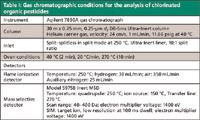
Table I: Gas chromatographic conditions for the analysis of chlorinated organic pesticides
Chemicals used for testing were all obtained from Polyscience Inc. Cyclohexane was obtained from JT Baker. The limit of detection for the solutes of interest was calculated based on a signal-to-noise ratio of 3:1.
Results and Discussion
When analyzing for chlorinated pesticides such as lindane, aldrin, heptachlor epoxide, dieldrin, o,p-DDD, and DDT by GC, two main concerns must be addressed. The first is the decomposition of the compounds in the liner and the second is the adsorptivity of the solutes of interest by the GC system along the analyte's path. Both matters are addressed below.
Liner Selection
In general, GC inlet liners with quartz wool provide some distinct advantages compared to "wool-less" liners. The presence of wool aids in the vaporization of the liquid by providing extra surface and heat capacity for vaporization, retains nonvolatile sample residues, minimizes split discrimination with enhance mixing, and wipes the syringe needle upon sample dispensation. Until recently, the use of liners with quartz wool for pesticide analysis has been met with limited success because of the ineffectiveness of the manufacturers' deactivation process for both the wool and the inner surface of the liner.
Various liners were investigated in an attempt to find one that would show less adsorptivity toward the solutes of interest with an acceptable reproducibility of less than 5% RSD. The liner described in the experimental section was found to deliver the best overall and sustained performance for the application described as illustrated in Figure 1.

Figure 1: Chromatogram of 1.6 ppm (w/v) each of pesticides by GCâMS in SCAN mode. Peaks: 1 = octane, 2 = lindane, 3 = aldrin, 4 = heptachlor epoxide, 5 = dieldrin, 6 = o,p-DDD, and 7 = DDT.
Column Selection
Among stationary phases, polydimethylsiloxane offers the highest degree of inertness to active solutes, high chromatographic column efficiency, and strong resistance to hydrolysis. A 5% phenyl arylene column was selected to improve surface wettability for aqueous matrix and maintaining a high degree of inertness for active solutes, such as those being analyzed.
Figure 1 shows a chromatogram of 1.6 ppm (w/v) each of lindane, aldrin, heptachlor epoxide, dieldrin, o,p-DDD, and DDT. Note the respectable peak symmetry obtained for the compounds mentioned, including those that are highly active such as lindane and DDT.
Clearly, the inertness of the system selected contributed to the overall chromatographic performance of the methodology developed.
Analytical Performance
Using the conditions outlined in Table I, the technique was evaluated for analytical performance. A complete analysis can be conducted in less than 20 min. Table II lists the retention and target mass fragments used for the solutes of interest.
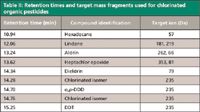
Table II: Retention times and target mass fragments used for chlorinated organic pesticides
The practical detection limits obtained were 5 ppb (w/v) for all solutes involved, as depicted in Figure 2. This is quite respectable when compared to published results of 5 ppb (w/v) with GC–MS-MS (16) despite the fact that the detector used was a single-quadrupole mass spectrometer.

Figure 2: Chromatogram of 8 ppb (w/v) of targeted solutes.
A precision study was conducted for the compounds of interest. At a concentration of 16 ppb (w/v), the RSD at the 95% confidence level was less than 5% (n = 10). The respectable reproducibility obtained substantiated the overall inertness of the analytical system with a minimal or nondetectable level of solute decomposition at the level studied.
Linearity also was acceptable for all compounds. Linearity data were collected between 8 ppb (w/v) and 320 ppb (w/v) for all compounds. R2 values greater than 0.999 were obtained and the results are illustrated in Figure 3. It can be inferred that with the excellent correlation coefficients obtained for highly reactive solutes, such as lindane, aldrin, and DDT, if decomposition of solutes occurred it was at an insignificant level over a range of 5 ppb to 320 ppb (w/v) for the solutes cited.
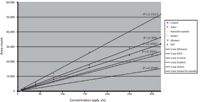
Figure 3: Linear curves for targeted solutes.
With a proper sample preparation technique, this analytical method can be used to analyze for said components in different matrices. Figure 4 shows a chromatogram of 800 ppb (w/v) each of the solutes of interest spiked into a dried, and sieved bioremediated locally obtained soil and subsequently extracted with 5 mL of dichloromethane followed by 10 min of sonication. A recovery of greater than 92% for all analytes was obtained. Commercially available lice treatment shampoos can contain lindane as an active ingredient. A 1-mL sample of the medicated shampoo was extracted with 10 mL of water for surfactants removal, and the subsequent extract was exchanged with 2 mL of dichloromethane. Figure 5 shows a chromatogram obtained with GC–MS in SIM mode using 181 Da as the target ion, illustrating the presence of lindane in the extract. The same sample also was analyzed by GC coupled to flame ionization detection (FID). Figure 6 shows an overlay of a chromatogram of a standard with the sample of interest. The presence of lindane was identified by retention time along with other detectable components in the extract. The selectivity and sensitivity improvements obtained with GC–MS in SIM mode can be advantageous in screening for the presence of the targeted pesticides in various matrices.
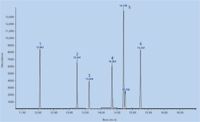
Figure 4: Chromatogram of 800 ppb (w/v) of targeted solutes spiked into a dried, sieved bioremediated soil. Peaks: 1 = lindane, 2 = aldrin, 3 = heptachlor epoxide, 4 = dieldrin, 5 = o,p-DDD, and 6 = DDT.
Conclusions
The analysis of low-level chlorinated pesticides by GC has been challenging because of the adsorptivity of these compounds in the chromatographic system.
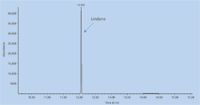
Figure 5: Chromatogram of an extract of medicated shampoo with GCâMS in SIM mode.
The practical and simple GC method described in this article combines an inert liner, a well-deactivated capillary column, and a mass-selective detector and enables the direct measurement of ultratrace parts-per-billion levels of lindane, aldrin, heptachlor epoxide, dieldrin, o,p-DDD, and DDT. This technique has demonstrated a high degree of reliability and is sufficiently rugged for implementation in plant laboratory facilities.

Figure 6: Overlay of a pesticide standard and an extract of medicated shampoo with GCâFID.
Acknowledgments
Special thanks to Dan Martin and Dave Walter of the Dow Analytical Technology Center for their support and encouragement. Dr. Taylor Hayward is also acknowledged for the fruitful discussion on the topic of the impact of pesticides in environment.
References
(1) R. Soniassy, P. Sandra, and C. Schlett, Water Analysis, Organic Micropollutants, Hewlett-Packard Co. 141 (HP part N 5962-6216E) (1994).
(2) C. Poole, The Essence of Chromatography (Elsevier, Amsterdam, The Netherlands, 2003).
(3) W. Jennings, E. Mittlefehldt, and P. Stremple, Analytical Gas Chromatography (Academic Press, New York, New York, 2006).
(4) W. Jennings, Applications of Gas Capillary Gas Chromatography (Marcel Dekker, New York, New York, 1981).
(5) R. Freeman, High Resolution Gas Chromatography (Publ. 5950-3562, Hewlett-Packard, Avondale, Pennsylvania, 1979).
(6) K. Neuber, M. Gunter, and R. Randow, J. Chromatogr. A 107, 189 (1999).
(7) M. Gfrerer and E. Lankmayr, J. Chromatogr. A 1072, 117 (2005).
(8) L. Tudir, T. Harner, P. Blanchard, Y. Li, L. Poissant, D. Waite, C. Murphy, and W. Belzer, Atmosph. Environ. 40, 1563 (2006).
(9) M. Abb, J. Breuer, C. Zeitz, and W. Lorenz, Chemosphere 81, 488 (2010).
(10) M. Cooke, K. Khalief, G. Nickless, and D. Roberts, J. Chromatogr. A 178, 163 (1979).
(11) C. Bicchi, C. Brunelli, C. Cordero, P. Rubiolo, M. Galli, and A. Sironi, J. Chromatogr. A 1071, 3 (2005).
(12) H. Li, G. Li, and J. Jen, J. Chromatogr. A 1012, 129 (2003).
(13) N. Ochiai, T. Leda, S. Sasamoto, Y. Takazawa, and S. Hashimoto, J. Chromatogr. A 1218, 6851 (2011).
(14) US Environmental Protection Agency, "Pesticides: Analytical Methods and Procedures, Index of Residue Analytical Methods (RAM)" (1994).
(15) US Environmental Protection Agency, "Residue Chemistry Test Guidelines, OPPTS 860.1340, Residue Analytical Method," EPA 712-C-95-174 (1995).
(16) L. Zhao, D. Mao, M. Hastings, A. Vickers, A. Broske, and L. Miller, "Application of Agilent Ultra Inert Liners with Wool for the Analysis of Active Analytes by GC–MS and GC–MS-MS," presented at Pittcon 2011, Atlanta, Georgia, 2011.
Kaelyn Gras is a student at Archbishop MacDonald High School in Edmonton, Alberta, Canada.
Jim Luong is an associate technology director at Dow Chemical Canada ULC, in the Analytical Technology Center located in Fort Saskatchewan, Alberta, Canada.
Ronda Gras is an associate analytical manager at Dow Chemical Canada ULC, in the Analytical Technology Center, located in Fort Saskatchewan, Alberta, Canada. Please direct correspondence to: rgras@dow.com.

Detecting Hyper-Fast Chromatographic Peaks Using Ion Mobility Spectrometry
May 6th 2025Ion mobility spectrometers can detect trace compounds quickly, though they can face various issues with detecting certain peaks. University of Hannover scientists created a new system for resolving hyper-fast gas chromatography (GC) peaks.
University of Oklahoma and UC Davis Researchers Probe Lipidomic Profiles with RP-LC–HRMS/MS
May 6th 2025A joint study between the University of Oklahoma Health Sciences Center (Oklahoma City, Oklahoma) and the UC Davis West Coast Metabolomics Center (Davis, California) identified differentially regulated lipids in type 2 diabetes (T2D) and obesity through the application of reversed-phase liquid chromatography-accurate mass tandem mass spectrometry (RP-LC-accurate MS/MS).
Automated Sample Preparation (ISO 20122) for MOSH/MOAH in Seasoning Oils
May 6th 2025This work presents an Automated Sample Preparation procedure for MOSH/MOAH analysis of Seasoning Oils. We compare results from a manual epoxidation procedure compliant with DIN 16995 with results based on fully automated sample preparation (epoxidation and saponification) compliant with ISO 20122. In both cases, online clean-up via activated aluminum oxide (AlOx) are used to remove interfering n-alkanes from the MOSH fraction during the HPLC run. Automated data evaluation using a dedicated software (GERSTEL ChroMOH) is presented.

.png&w=3840&q=75)

.png&w=3840&q=75)



.png&w=3840&q=75)



.png&w=3840&q=75)









